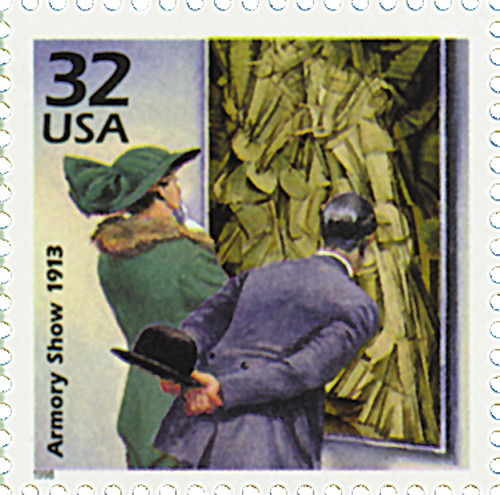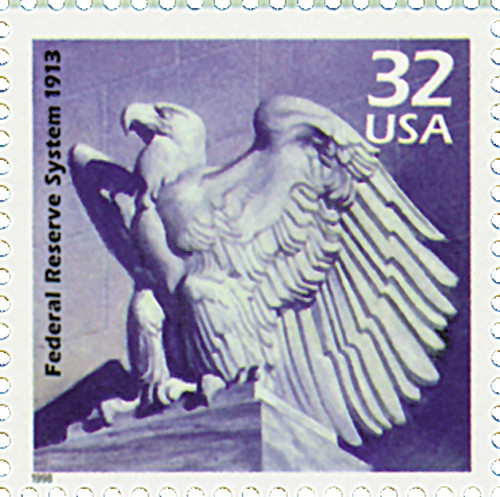
# 3183a - 1998 32c Celebrate the Century - 1910s: Charlie Chaplin
US #3183a
1998 Charlie Chaplin’s Little Tramp – Celebrate the Century (1910s)
• Part of the second sheet in the Celebrate the Century stamp series issued from 1998-2000
• Honors Charlie Chaplin
• Includes text on the back with historical details
Stamp Category: Commemorative
Series: Celebrate the Century
Value: 32¢ First Class Mail Rate
First Day of Issue: February 3, 1998
First Day City: Washington, DC
Quantity Issued: 188,000,000
Printed by: Ashton Potter (USA) Ltd.
Printing Method: Offset, Intaglio
Format: Panes of 15
Perforations: 11.6
Tagging: Block Tagging
Why the stamp was issued: To commemorate Charlie Chaplin and his iconic “Little Tramp” character.
About the stamp design: Pictures an oil painting of Charlie Chaplin by artist Dennis Lyall. Includes the following text on the back “Charlie Chaplin first assumed his famous costume for the Little Tramp in 1914. The clothes, mustache, cane, and walk came to identify one of the most familiar icons in the history of film.”
First Day City: The First Day of Issue Ceremony was held in Washington, DC, with legendary radio and television host Larry King as master of ceremonies.
About the Celebrate the Century series: The USPS launched the Celebrate the Century series in 1998 to mark the end of the 20th century and herald the arrival of the 21st. The series includes 10 sheets of 15 stamps (150 in total), with each honoring important moments from a different decade (1900s, 10s, 20s, 30s, 40s, 50s, 60s, 70s, 80s, and 90s). At the time of completion, it was the longest and most ambitious commemorative stamp series in US history.
History the stamp represents: Charles Spencer “Charlie” Chaplin was born on April 16, 1889 in South London, England. Born to music hall entertainers, Chaplin’s childhood was one of poverty and hardship. His parents were both ill and had trouble finding work. They sent him to a workhouse when he was just seven years old to help provide for the family.
Amidst his difficult childhood, Chaplin discovered his talent for acting, making his first stage appearance at just five years old. At 19, Chaplin toured Britain with the Fred Karno Company and, in 1910, he made his first trip to America. In 1913, Mack Sennett, a producer in the new field of “flickers,” saw Chaplin’s act and offered him a part. At first, Chaplin was hesitant to leave the stage for films, but his mind was made up when he heard he could make $150 a week (about $22,400 in today’s wages).
In 1914, Chaplin made his debut in a short film called Making a Living. Wanting to stand out, he put together a costume of oversized pants, a tight coat, a derby hat, and a cane. His character, “The Little Tramp,” was an instant success and became one of the most popular and easily recognizable figures of the 20th century. Using his wild imagination, Chaplin transformed dinner rolls into ballet shoes or a worn boot into a feast fit for a king.
US #3183a
1998 Charlie Chaplin’s Little Tramp – Celebrate the Century (1910s)
• Part of the second sheet in the Celebrate the Century stamp series issued from 1998-2000
• Honors Charlie Chaplin
• Includes text on the back with historical details
Stamp Category: Commemorative
Series: Celebrate the Century
Value: 32¢ First Class Mail Rate
First Day of Issue: February 3, 1998
First Day City: Washington, DC
Quantity Issued: 188,000,000
Printed by: Ashton Potter (USA) Ltd.
Printing Method: Offset, Intaglio
Format: Panes of 15
Perforations: 11.6
Tagging: Block Tagging
Why the stamp was issued: To commemorate Charlie Chaplin and his iconic “Little Tramp” character.
About the stamp design: Pictures an oil painting of Charlie Chaplin by artist Dennis Lyall. Includes the following text on the back “Charlie Chaplin first assumed his famous costume for the Little Tramp in 1914. The clothes, mustache, cane, and walk came to identify one of the most familiar icons in the history of film.”
First Day City: The First Day of Issue Ceremony was held in Washington, DC, with legendary radio and television host Larry King as master of ceremonies.
About the Celebrate the Century series: The USPS launched the Celebrate the Century series in 1998 to mark the end of the 20th century and herald the arrival of the 21st. The series includes 10 sheets of 15 stamps (150 in total), with each honoring important moments from a different decade (1900s, 10s, 20s, 30s, 40s, 50s, 60s, 70s, 80s, and 90s). At the time of completion, it was the longest and most ambitious commemorative stamp series in US history.
History the stamp represents: Charles Spencer “Charlie” Chaplin was born on April 16, 1889 in South London, England. Born to music hall entertainers, Chaplin’s childhood was one of poverty and hardship. His parents were both ill and had trouble finding work. They sent him to a workhouse when he was just seven years old to help provide for the family.
Amidst his difficult childhood, Chaplin discovered his talent for acting, making his first stage appearance at just five years old. At 19, Chaplin toured Britain with the Fred Karno Company and, in 1910, he made his first trip to America. In 1913, Mack Sennett, a producer in the new field of “flickers,” saw Chaplin’s act and offered him a part. At first, Chaplin was hesitant to leave the stage for films, but his mind was made up when he heard he could make $150 a week (about $22,400 in today’s wages).
In 1914, Chaplin made his debut in a short film called Making a Living. Wanting to stand out, he put together a costume of oversized pants, a tight coat, a derby hat, and a cane. His character, “The Little Tramp,” was an instant success and became one of the most popular and easily recognizable figures of the 20th century. Using his wild imagination, Chaplin transformed dinner rolls into ballet shoes or a worn boot into a feast fit for a king.














